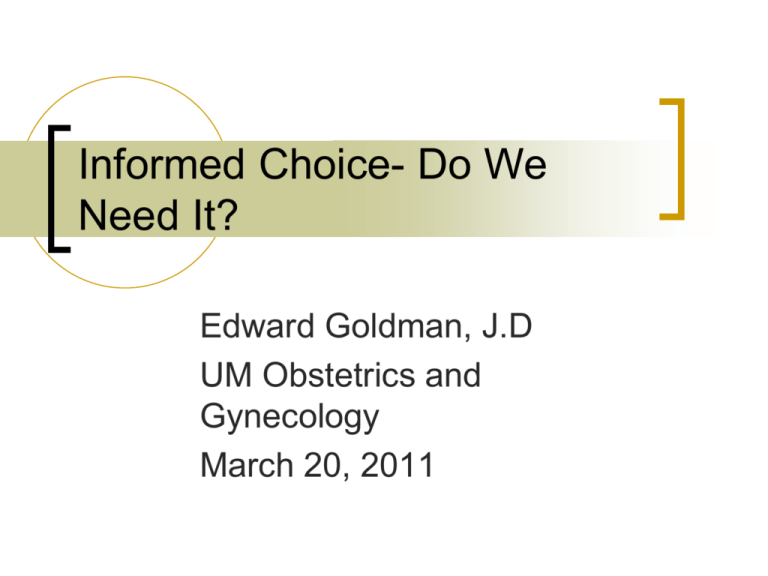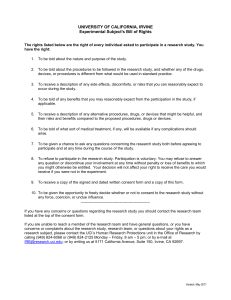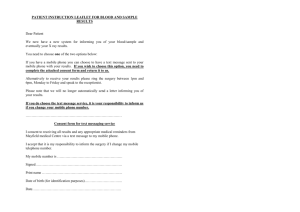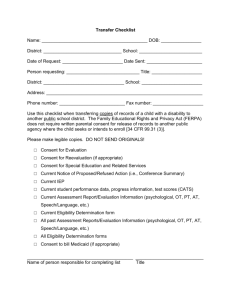Informed Choice- legal issues
advertisement

Informed Choice- Do We Need It? Edward Goldman, J.D UM Obstetrics and Gynecology March 20, 2011 Introduction We will discuss patient consent or refusal of non-emergency treatment. Legal issue: No touching unless you have permission. Medical issue: Forging a therapeutic alliance with your patient. Ethical issue: Doing the right thing. Law and Ethics The legal system sets fixed rules to guide conduct. The rules may be seen by some as arbitrary. The systems of ethics (and there are various systems) seek to create a moral framework for discussion of important societal issues. Various Approaches Consent: The Good, the Bad and the Ugly. (Doctors arguing that consent is an illusion) Consent: Let’s Make a Deal. Consent: Moving away from the patient as passive to the patient as participant. Law and Ethics Revisited Not always the same. In our discussion law and ethics may overlap since obtaining patient permission is both legally required and the “right thing to do”. Good process should help create trust, rapport and alliance by showing respect for the patient. “Are you telling me that just because something is against the law, that makes it illegal?” The Basics Informed Choice is a process of information exchange with: A competent (understands nature/consequences of actions) uncoerced patient who understands the procedure, its risks, benefits and alternatives then makes a free informed choice. The Elements of Choice Nature of the procedure Its risks and possible benefits Alternatives to the procedure Competent patient, engaged professional No coercion or duress A full discussion and documentation. The Professional-Client Model A fiduciary relationship. 1. What are the facts (prognosis) 2. What limits exist (“I can’t prescribe a non-FDA approved drug”) 3. What are the options (various treatments, research, doing nothing) 4. What are the client’s values? The Professional-Client Model 5. What does the professional recommend and why? (i.e. What are the available options? Are there some options that are professionally unacceptable? Ex: Violation of the law, un-approved medical practices, outcome unacceptable to the provider?). 6. How free is the client to make choices (take this treatment or stay sick)? Difficult Issues The next few slides will cover various difficult cases. Note: the underlying problems are the same for providers, lawyers, other professionals. i.e. what are the limits for professionals when a party seeks professional advice and assistance? Informed Refusal Patient is told the indicated procedure, its risks, benefits and alternatives and patient refuses. If injury occurs can patient claim malpractice? Ex: Patient refuses all ultrasound then has a life threatening bleed from an undiagnosed placenta previa. Why refusal? Belief that US causes autism. Patient Chooses- Provider Does Not Agree Must all patient choices be honored? What if the choice violates your beliefs (abortion, unconventional therapy) or professional rules (illegal drugs). Resolution: Parting of the ways in extreme cases but must counsel and be sure patient will not be abandoned first. Query: Conscience Clause. Rules to Avoid Abandonment 1. Tell patient what the disagreement is and what options you are willing to provide. No guilt or blaming. 2. If patient disagrees then provide a period of time to allow transfer of care. 3. Do not discontinue care if that would result in avoidable injury. Document. Provider-Patient Disagreement Ranges from minimal (listen to heart tones with fetoscope versus ultrasonic fetal monitor) where provider may be willing to follow patient’s request, to maximal ( once distress is detected more invasive monitoring is medically necessary) where provider is not willing to follow the patient’s request. The Limits of Autonomy 1 Case: 24 yr. old recently married patient wants an abortion for a 6 week pregnancy. Her BP is high (157/99). A review of her medical records shows 6 months of untreated elevated pressures. You offer surgical versus medical abortion. Patient refuses surgical. The Limits of Autonomy 2 You fully discuss risks of stroke with medical approach. Pat. says she understands then says: “Now can I have the pill?” You refuse. Informed choice or physician’s right (fiduciary obligation?) to refuse? Can provider’s treatment of a medical condition trump patient’s autonomy? The Limits of Autonomy 3 In the prior refusal of ultrasound with a placenta previa example assume the baby is born damaged. Mother may not have a successful legal claim because we documented an informed refusal. Does baby have an independent claim? The Limits of Autonomy 4 In the 2001 case of Nold v. Binyon, 31 P.3d 274, the Kansas Supreme Court decided a physician has a doctor-patient relationship with both mother and any developing fetus she intends to carry to a healthy full term. In Nold, the infant was born with hepatitis B, transmitted from her infected mother. Doctor knew mother had Hep B. Treatment is to administer gamma globulin and a vaccine at birth; the infant received neither and so contracted the virus. The Limits of Autonomy 5 States may allow a child to sue for prenatal injuries, but the vast majority of states do not allow "wrongful life" actions. In a WRONGFUL LIFE lawsuit, the child sues for failure to diagnose a severe, disabling condition of the child before birth. The argument is that if the doctor had informed the child's parents of the child's condition, the mother would have had an abortion. The child's theory is that life with the injury or debilitating condition is worse than no life at all. Most courts say they cannot determine that non-existence is preferable to diminished existence. The Limits of Autonomy 6 Courts support the rights of mothers to refuse recommended C-Sections. Courts have not granted rights to the fetus as an independent person. In re: AC, 1990. Appeals court judge is reported to have asked, "Are you urging this court to find that you can handcuff a woman to a bed and force her to give birth?" The Limits of Autonomy 7 ACOG Committee on Ethics 11-2005 says “Efforts to use the legal system to protect the fetus by constraining pregnant women’s decision making or punishing them erode a woman’s basic rights to privacy and bodily integrity and are not justified.” Autonomy-Not a Trump Card ? Autonomy is a basic ethical principle as is beneficence - doing what is best for the patient. Which principle governs? Autonomy means that a patient must be included in decision making, and can refuse the recommended treatment. Issue: Can the provider then say that care cannot continue under the conditions set by the patient? How about invasive care without consent? A Note About Ethics The true ethical principle is not “autonomy” but instead is “Respect for Persons”- an idea that we should “give weight to autonomous persons' considered opinions and choices while refraining from obstructing their actions unless they are clearly detrimental to others. To show lack of respect for an autonomous agent is to repudiate that person's considered judgments, to deny an individual the freedom to act on those considered judgments, or to withhold information necessary to make a considered judgment, when there are no compelling reasons to do so.” Belmont Report 1979 Minors Minors can consent for certain things as allowed by State law (Ex: birth control information and pregnancy related care) Basic Rule: Parent/guardian consents. Exceptions: Emancipated minor (married, armed forces, court order), State law, mature minor rule. Parental Refusal 1 Minor needs treatment (blood transfusion, cancer therapy) but parents refuse for religious or other reasons. 1. Knowing parental refusal? Will counseling help? 2. How medically necessary is the care? Abuse or neglect? 3. As minor matures courts evaluate ability to understand and assent to the proposed treatment. Parental Refusal 2 Parents do not want chemotherapy because chance for cure is low and treatment causes pain. Provider says doing something is better than doing nothing. Role for Ethics Committee? Switch provider? Court order? (last resort if there is a reasonable medical chance for cure) Parental Refusal 3 If life or limb at risk courts will usually order care. What if care is “futile” but mother demands it? In re: Baby K (Va. 1994) where the court ordered treatment for anencephaly. Theory: EMTALA, ADA and mother’s choice controls. Incompetent Patients If adult but never competent due to mental status then guardian decides. If adult but transitorily incompetent (coma) then Durable Power of Attorney (with named Advocate) or Spouse or guardian decides. Ex: Sterilization of incompetent adult. In re: Lora Fay Wirsing (Mi. 1998) Research and Consent Be sure patient understands that research is not therapy. Problem: Confusion between role as provider and role as researcher. Rules of research found in 45 CFR 46 written as a reaction to past abuses (Tuskegee, Willowbrook) say consent is essential but also allow for a waiver. Stubborn Patients Patient needs dialysis but only wants treatment on her schedule. How to manage? Behavioral contracts and consent. Involving the legal system. Ex: Payton v. Weaver, Calif. 1995. Issue: Can consent really be court mandated? “Life is not Worth Living” Patients Patient wants to consent to: 1. provider assisted suicide 2. euthanasia 3. withdrawal of life support 4. treatment felt by provider to be “futile”. Where can/should provider (society?) “draw the line” with patient autonomy? Testing for HIV Most States require prior written permission and pre and post test counseling for HIV tests But, if there is health care worker exposure testing can occur without consent and even over the patient’s express refusal. Uniform Anatomical Gift Act Patient, while living, expresses intent to donate organs upon death. Organs are viable after death but family members refuse to allow donation to occur. Must patient wishes be honored? Does patient have priority over family? What if patient said no but family wish to donate? Are the rules symmetrical? Exceptions to Need for Consent Emergency Unforeseen developments in surgical procedure (No need to wake patient up for permission if immediate medically necessary action is required) Newborn Screening Others? (consent implied from patient conduct Ex: routine procedures) Documenting the Decision Remember that the process of arriving at a decision is a conversation. Once a decision is made it is documented on an “Informed Consent” form but that form is the outcome and not a substitute for the process of information exchange. Consent-Do we Need It? Allows clarity for who decides. (Ex: specific rights for minors) Allows clarity for what decisions can be made. End of life, suicide. Allows a defense in court for lack of consent cases. Shows respect and helps build a sound provider-patient relationship Case Study #1 24 year old woman undergoing fertility treatment. 12 eggs obtained and fertilized. She wants to have 6 embryos frozen and 6 inserted. Current practice, per specialty guidelines, is to insert no more than 2 embryos. Case Study #2 Provider wants to enroll pregnant woman in a phase 3 research protocol with direct relevance to an otherwise untreatable medical condition (in mother? Fetus?). How to proceed? Must both mother and father consent? Case Study #3 Pregnant woman in ICU with eclampsia. It’s day 5 and patient is stable and ready for transfer to general unit. Patient refuses transfer because she believes care is better in ICU. How to proceed? Justice issues? Allocation of scarce resources issues? Case Study #4 Competent 24 year old with heavy bleeding requesting hysterectomy. Had not exhausted medical therapy but is “fed up” and wants the surgery. “Everyone else in my family had one by age 30.” Provider not ready to move to surgery. Case Study #5 Gravida 1 wants C-Section to preserve her perineum. No medical indication for C-Section. Professional societies (ACOG and NIH) says patient gets to choose. Provider not sure this is in patient’s best interests. When Policies Clash “…the emerging norm of patient autonomy (which) has contributed to the erosion of the professional stature of medicine…an emphasis on mutual responsibility has been gradually supplanted by an emphasis on individual rights.” R. Alta Charo, The Celestial Fire of Conscience, NEJM 352:24, 06-16-05 Conclusion Informed choice is a process of information exchange resulting in an informed patient who understands the medical choices and medical chances in the relevant medical interaction and who can partner with you to make “good” decisions. Remember… These are emotional and difficult situations where excellent listening and communication skills are critical. If you have one of these situations and feel comfortable (“This is easy”) then question your assumptions. If it feels difficult you are probably on the right track.







